Archived Storm Damage Blog Posts
How to Check for a Leaky Roof
11/7/2022 (Permalink)
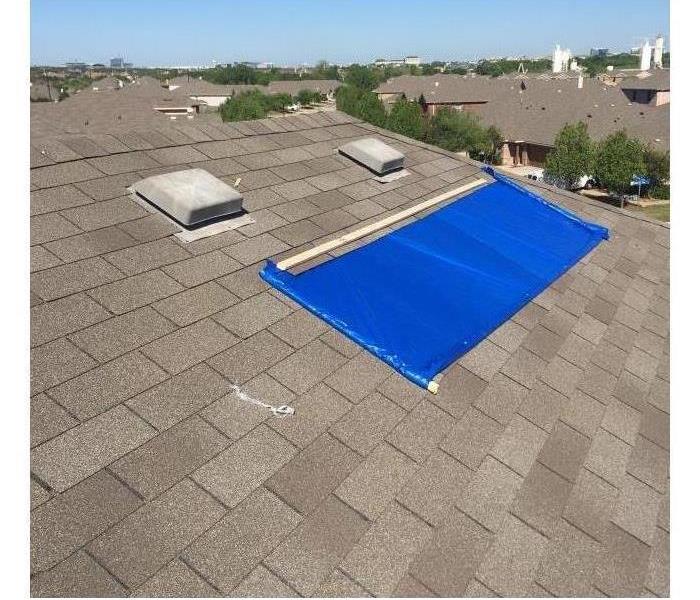 Always remember if you ever find yourself with a failed roof causing water damage to your home and in need of repairs after call SERVPRO.
Always remember if you ever find yourself with a failed roof causing water damage to your home and in need of repairs after call SERVPRO.
Roof’s get old and worn down. If not replaced can start leaking water during rain periods. Let’s talk about how to detect a roof leak, that way you can do regular checks to be on the safe side.
- Go in the attic with a flashlight, during or shortly after a heavy rain, being careful not to step through the ceiling. In the absence of rain, use a garden hose to thoroughly wet down the roof to create a manmade leak.
- Examine the roof decking (the wooden boards that make up the framing of your roof) and rafters in the attic above the spot where the ceiling is wet.
- Follow any water stains or wet spots up the rafters or roof decking to their highest point.
- Measure down from the roof peak to the highest point of the leak and over from a gable end to the leak.
- When the roof is dry, go on the roof, and transfer the measurements to the roof, allowing for any overhang on the end of the roof.
- Examine the roofing closely for signs of the leak at the location you measured.
- If you can’t see the source of the leak, continue to look higher up on the roof, since water can run down behind the shingles before emerging in the attic decking or rafters.
Always remember if you ever find yourself with a failed roof causing water damage to your home and in need of repairs after call Kimberly with SERVPRO of South Pasadena at (281) 520-8197 and we’ll be there to help you!
What to do Before, During, and After a Power Outage
6/6/2022 (Permalink)
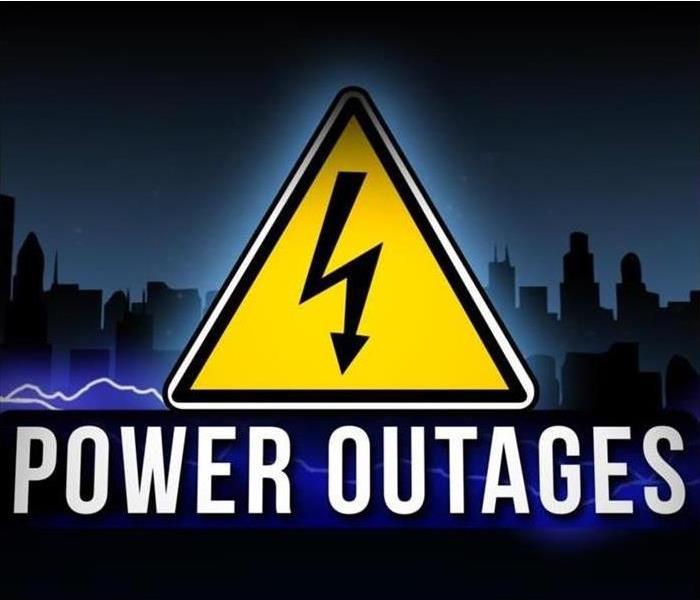 Stay safe this season by following these tips to know what to do before, during, and after a power outage!
Stay safe this season by following these tips to know what to do before, during, and after a power outage!
Ready, a national public service advertising campaign, gives us these tips to follow before, during, and after a power outage.
Before
- Build or restock your emergency preparedness kit, including a flashlight, batteries, cash, and first aid supplies.
- Make sure you have alternate charging methods for your phone or any device that requires power.
- Charge cell phones and any battery powered devices
- Know where the manual release lever of your electric garage door opener is located and how to operate it.
- Purchase ice or freeze water-filled plastic containers to help keep food cold during a temporary power outage.
- Keep your car’s gas tank full. Gas stations rely on electricity to power their pumps. If you use your car to re-charge devices, do NOT keep the car running in a garage, partially enclosed space, or close to a home, this can lead to carbon monoxide poisoning.
- Learn about the emergency plans that have been established in your area by visiting your states or local website so you can locate the closest cooling and warming shelters.
- If you rely on anything that is battery-operated or power dependent like a medical device, determine a back-up plan.
During
- Only use flashlights for emergency lighting, candles can cause fires.
- Keep refrigerator and freezer doors closed. Most food requiring refrigeration can be kept safely in a closed refrigerator for several hours. An unopened refrigerator will keep food cold for about 4 hours. A full freezer will keep the temperature for about 48 hours.
- Put on layers of warm clothing if it is cold outside. Never burn charcoal for heating or cooking indoors. Never use your oven as a source of heat. If the power may be out for a prolonged period, plan to go to another location that has heat to keep warm.
- Turn off or disconnect appliances and other equipment in case of a momentary power “surge” that can damage computers and other devices. Consider adding surge protectors.
- If you are considering purchasing a generator for you home, consult an electrician or engineer before purchasing and installing.
- Only use generators away from your home and NEVER run a generator inside a home or garage or connect it to your home’s electrical system.
After
- Throw away any food that has been exposed to temperatures 40 degrees Fahrenheit for 2 hours or more or that has an unusual odor, color, or texture. When in doubt, throw it out!
- If food in the freezer is colder than 40 degree Fahrenheit and has ice crystals on it, you can refreeze it
- Contact your doctor if you’re concerned about medications having spoiled.
- Restock your emergency kit with fresh batteries, canned foods, and other supplies.
https://www.ready.gov/power-outages
SERVPRO of S. Pasadena's main priority this season is safety. For any water or fire damage needs, feel free to call us at (713) 472-4162.
When Storms or Floods hit, SERVPRO is Ready!
6/6/2022 (Permalink)
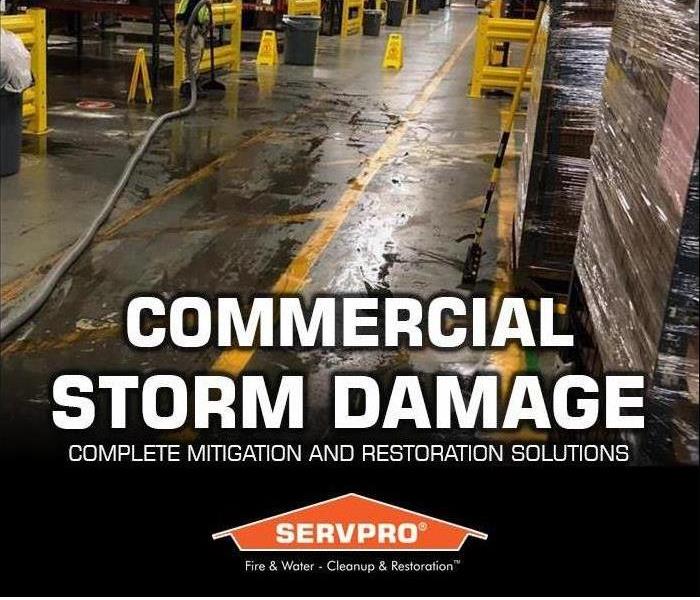 Storm Damage Cleanup and Restoration
Storm Damage Cleanup and Restoration
SERVPRO of S. Pasadena is faster to any size disaster and specializes in storm and flood damage restoration. Our crews are highly trained, and we use specialized equipment to restore your property to its pre-storm condition.
Faster Response
Since we are locally owned and operated, we are able to respond quicker with the right resources, which is extremely important. A fast response lessens the damage, limits further damage, and reduces the restoration cost.
Highly Trained Water Damage Specialists
SERVPRO of S. Pasadena professionals specialize in water damage restoration, the cornerstone of our business. We have extensive water damage restoration training with an emphasis on monitoring and documenting the drying process until completion.
Resources to Handle Floods and Storms
When storms hit Houston, we can scale our resources to handle a large storm or flooding disaster. We can access equipment and personnel from a network of 1,650 Franchises across the country and elite Disaster Recovery Teams that are strategically located throughout the United States.
Have Storm or Flood Damage? Call Us Today (713) 472-4162.
Preparing for Hurricanes
5/6/2022 (Permalink)
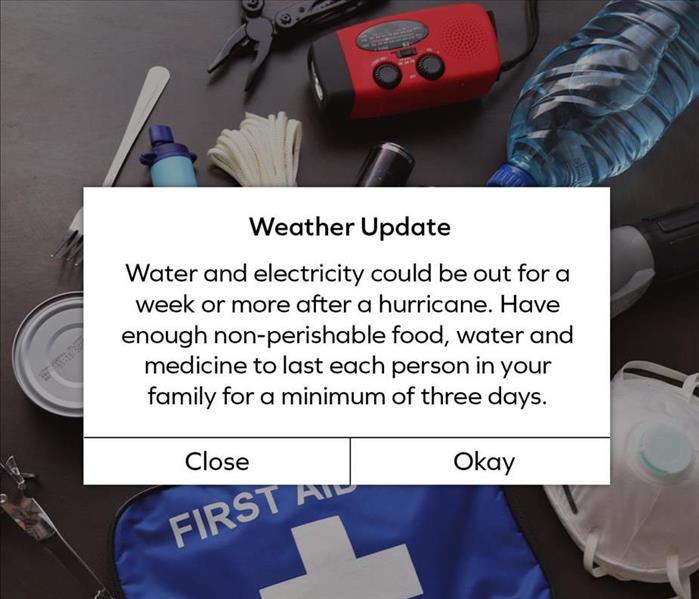 Have Storm or Flood Damage?
Call Us Today (713) 472-4162
Have Storm or Flood Damage?
Call Us Today (713) 472-4162
When preparing for hurricanes, having supplies to make it through the hurricane isn’t enough. Ensure you have supplies for the recovery period, which could be very long depending on the damage. For more tips on hurricane prep, visit http://bddy.me/******.
What To Do After Flooding
- Remove excess water by mopping and blotting.
- Wipe excess water from wood furniture after removal of lamps and tabletop items.
- Remove and prop wet upholstery and cushions.
- Place aluminum foil or wood blocks between furniture legs and wet carpeting.
- Turn air conditioning on for maximum drying in summer.
- Remove colored rugs from wet carpeting.
- Remove art objects to a safe, dry place.
- Gather loose items from floors.
What NOT To Do After Flooding
- Don't leave wet fabrics in place. Hang furs and leather goods.
- Don't leave books, magazines or other colored items on wet carpet or floors.
- Don't use your household vacuum to remove water.
- Don't use television or other household appliances.
- Don't turn on ceiling fixtures if ceiling is wet and keep out of rooms where ceilings are sagging.
The Different Types of Storm Damage
3/3/2022 (Permalink)
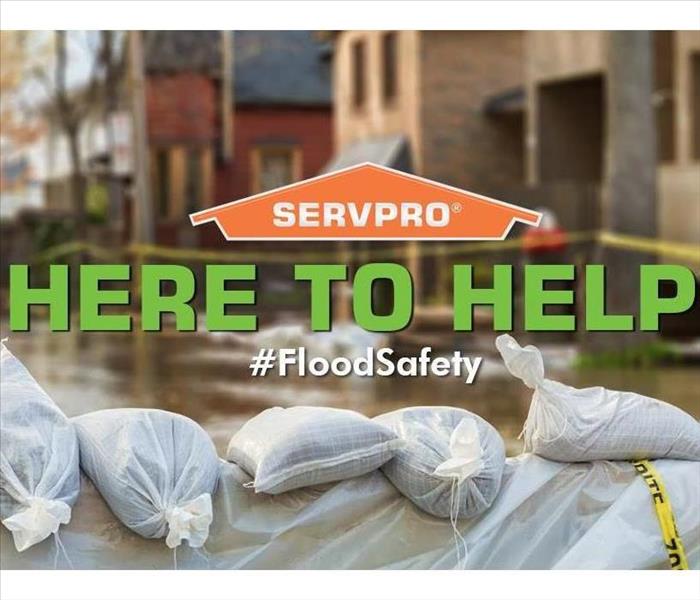 SERVPRO of South Pasadena is just a phone call away. We are here to help 24 hours a day, 7 days a week.
SERVPRO of South Pasadena is just a phone call away. We are here to help 24 hours a day, 7 days a week.
Flood damage, wind damage, and hail damage are all possibilities here in the Houston area. If storm damage hits your home or office, here are a few tips to help:
Flood Damage & Recovery
If your home or office space is near water, or in a low-lying area, flood water damage is a risk. Heavy rains and flooding may cause water damage. If the land around your home or business cannot redirect the additional water, flooding can happen. Even homes and businesses at higher elevations can sustain flood damage if frozen pipes break. As soon as you see flooding in your home, contact SERVPRO of South Pasadena (713) 472-4162to start the water mitigation process.
Wind Damage Restoration
Tornadoes often cause severe wind damage. Roof damage from strong winds may lift roof shingles, causing cracks, or even removing parts of an entire roof. Repairing roof damage may prove difficult for homeowners and business owners after a disaster due to damages that is not easily seen. If you have wind damage, make sure to ask for a professional to check your roof for moisture and signs of roof leaks.
Hail Damage & Recovery
Hail damage may be the most overlooked cause of major storm damage. Hail can damage not just your roof but also your siding, exterior walls, and windows. You may think your home or office has survived a hailstorm without damage, but hail damage can be difficult to identify. It would be a good idea to hire a roofing professional to inspect your roof and exterior walls for damage.
Impact Damage & Recovery
During a major storm it is not just wind, hail, and rain that can cause major damage to your home or business. Trees can cause horrendous damage just like weather can. Big trees are a huge bonus in a yard because they can produce shade but during a storm, they can cause damage. You will want to make sure that your trees are at least alive and there aren’t any branches that extend over your home or are breaking off. If you happen to have a tree fall on your home, not only could it damage the roof of your home or business, but the force from high winds and size of the tree could cause it to enter the home and damage the walls, flooring and content inside.
SERVPRO of South Pasadena is just a phone call away. We are here to help 24 hours a day, 7 days a week. No matter the size of your storm damage we will work to make it “Like it never even happened.”
Are you Prepared?
3/3/2022 (Permalink)
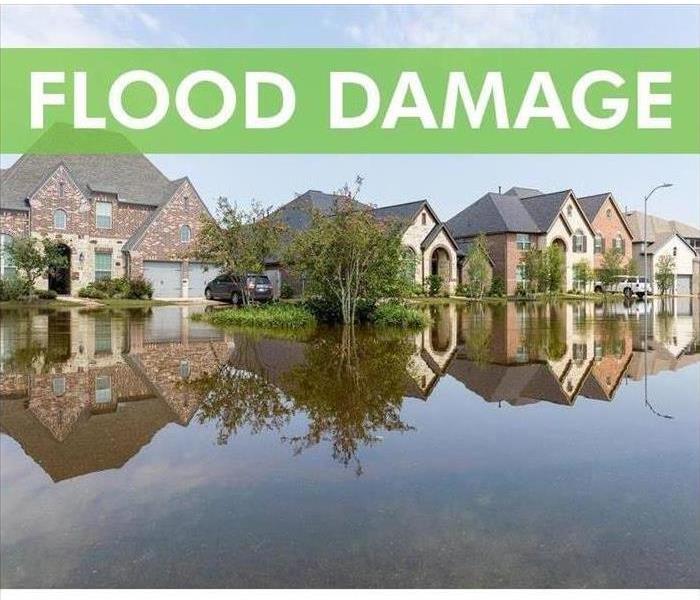 SERVPRO of S. Pasadena is here to help before & after the storm.
SERVPRO of S. Pasadena is here to help before & after the storm.
A well-equipped disaster supply kit should include, but is not limited to, the following items:
- Water: 1 gallon per person per day.
- Food: 3 to 7 days' worth of non-perishable or canned food and manual can opener.
- Bedding: Blankets and pillows.
- Clothing: Remember, although it may be warm, you may be working and cleaning and need pants and long sleeves to protect your skin.
- First Aid Kit: In the very least, include sanitizers and bandages.
- Cash: Keep some cash and small bills on hand in case banks are closed.
Prepare your home:
- Paperwork: Secure important documents
- Windows: Remove debris, trim trees
- Gas: Fill your car, fill your propane tank
SERVPRO of S. Pasadena is here to help before & after the storm. Proudly serving Houston and all surrounding areas.
Open 24/7!
Prepare Your Business For Storm Season
11/8/2021 (Permalink)
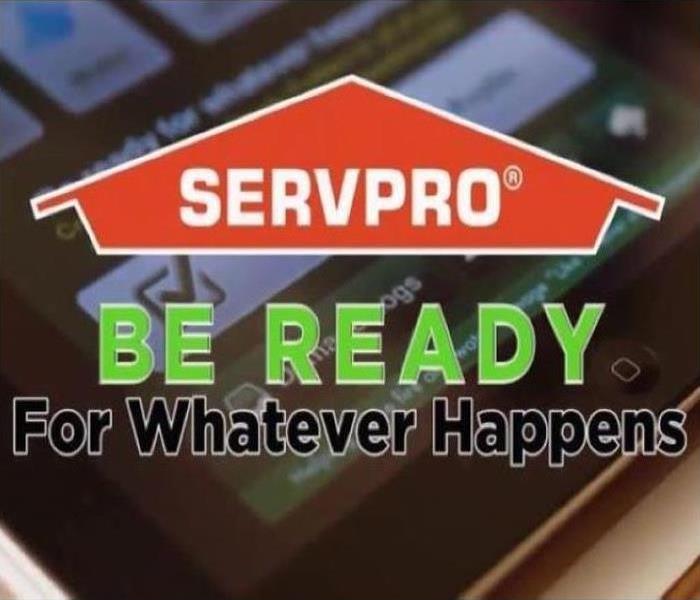 SERVPRO - Be ready for whatever happens!
SERVPRO - Be ready for whatever happens!
Partner with SERVPRO to Develop Your Personalized Emergency READY Profile (ERP) and Prepare for a Fast Response to Flood Damage
Although storm season is a yearly certainty, merely knowing the damaging heavy rainfall and winds are possible does not limit the effect of a storm that strikes close to you. Devastating damage can still threaten closure and loss of business. No restoration company can stop a tropical storm from causing structural damage and flooding, but our forward-thinking mitigation and remediation experts can assess your property’s vulnerabilities and put together a blueprint of the most effective way our restoration crews can respond to get you back to business fast and make it "Like it never even happened."®
How Does the Emergency Ready Profile and Plan (ERP) Work?
Put yourself in control of your business’ flooding damage by taking proactive action. Invite our trained and experienced project managers to come and assess your structural layout so we can create a plan that you can use to assist against potential flooding damage in two distinct ways:
We look for ways your current operation can be reconfigured to limit the effects of flood damage:
• Storing documents off-site or in water-proof containers
• Converting records to a digital form
• Raising equipment off of the floor
• Protecting inventory by choosing safer spaces for storage in your building, containment, or periodic off-site storage
We familiarize ourselves with your layout and ways of operating, and identify the likely path of flood waters entering and the best operational path towards mitigation:
• Label utility shut-offs
• Note recesses and building cavities that could trap water
• Develop a response plan with your input
• Clarify that SERVPRO of South Pasadena is your preferred restoration company
• Define the reconstruction costs associated with different levels of damage, so you can plan ahead of disasters and have response funds in place for quick mitigation and restoration
• Provide contact information for vendors and contractors who developed your space and systems
• Designate individuals whom you authorize to act on your behalf if you are unavailable during the crisis
Work with SERVPRO of South Pasadena to create a comprehensive ERP and ride out this storm season, knowing you are well-prepared for any disaster. Call (713) 472-4162 now to schedule your no-obligation assessment.
Be Ready!
7/1/2021 (Permalink)
 Pre-planning can serve as an insurance policy aimed at peace of mind.
Pre-planning can serve as an insurance policy aimed at peace of mind.
Our app is a no-cost readiness plan that places your ready plan data on your mobile device for quick access during an emergency. Ready Plan | SERVPRO Ready Plan
By developing a SERVPRO Emergency READY Profile for your business, you minimize business interruption by having an immediate plan of action. Knowing what to do and what to expect in advance is the key to timely mitigation and can help minimize how water and fire damage can affect your business.
- A no cost assessment of your facility.
This means there is no need to allocate funds, giving you a great value at no cost.
- A concise Profile Document that contains only the critical information needed in the event of an emergency.
It will only take a little time to complete and will not take you away from current projects. But it will save a lot of time if ever needed.
- A guide to help you get back into your building following a disaster.
This can help minimize the amount of time your business is inactive by having an immediate plan of action.
- Establishes your local SERVPRO Franchise Professional as your disaster mitigation and restoration provider.
You have a provider that is recognized as an industry leader and close by.
What to do Before, During, and After a Power Outage
6/30/2021 (Permalink)
 Stay safe this season by following these tips to know what to do before, during, and after a power outage!
Stay safe this season by following these tips to know what to do before, during, and after a power outage!
We’re more vulnerable to power outages this time of year because of new growth and leaves that are still on the trees, which can pull branches down. Ready, a national public service advertising campaign, gives us these tips to follow before, during, and after a power outage.
Before
- Build or restock your emergency preparedness kit, including a flashlight, batteries, cash, and first aid supplies.
- Make sure you have alternate charging methods for your phone or any device that requires power.
- Charge cell phones and any battery powered devices
- Know where the manual release lever of your electric garage door opener is located and how to operate it.
- Purchase ice or freeze water-filled plastic containers to help keep food cold during a temporary power outage.
- Keep your car’s gas tank full. Gas stations rely on electricity to power their pumps,. If you use your car to re-charge devices, do NOT keep the car running in a garage, partially enclosed space, or close to a home, this can lead to carbon monoxide poisoning.
- Learn about the emergency plans that have been established in your area by visiting your state’s or local website so you can locate the closest cooling and warming shelters.
- If you rely on anything that is battery-operated or power dependent like a medical device, determine a back-up plan.
Storm Damage?
6/17/2021 (Permalink)
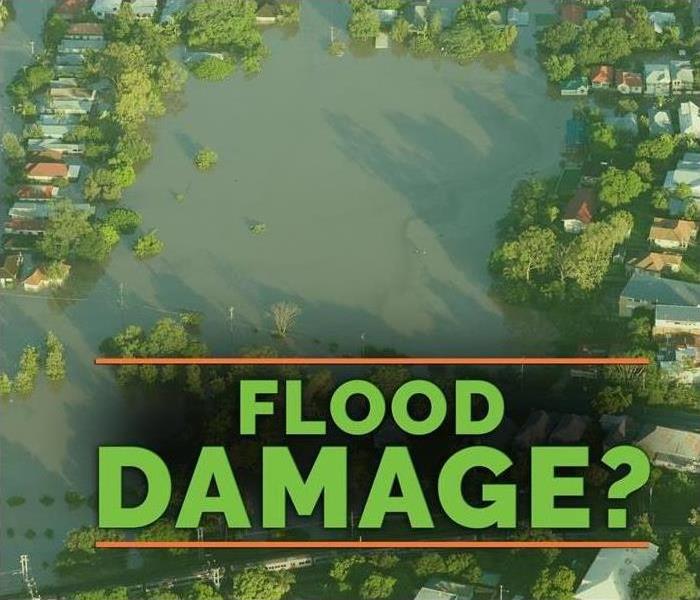 We respond to storm damage emergencies 24-hours a day.
We respond to storm damage emergencies 24-hours a day.
Flooding in the Houston area?Flood Factor is a great resource for finding out the probability of flooding where you live. It is a free online tool created by the nonprofit First Street Foundation. It makes it easy for Americans to find their property’s risk of flooding and to understand how flood risks are changing because of a changing environment. According to Flood Factor, Pearland properties have a 31% risk of flood exposure. Houston sits at 34%.
SERVPRO® of South Pasadena has been helping the Houston and surrounding communities mitigate flood damage for years, and we know that our fast response time helps to minimize the damage and cost of repairs in many cases. Here are some storm and water damage safety tips from our website:
Safety First:
- Stop the source of water damage; call a plumber/or wait for the storm to end
- Turn off the electricity
- If it is not safe to stay in the house, evacuate everyone, including pets
- Have all your relevant documents in one safe, dry place
- If you have homeowner’s insurance, start the claims process
- Document everything with photos, and wear protective gear
- If you are a tenant, reach out to your landlord or property manager
Call Us Today!
When your home or business experiences flooding, SERVPRO® of South Pasadena is Here to Help. ® Call us today at (713) 472-4162. We’ll clean and restore your storm damage, “Like it never even happened.”
SERVPRO of South Pasadena is Independently Owned and Operated.
Do You Need Flood Insurance?
6/1/2021 (Permalink)
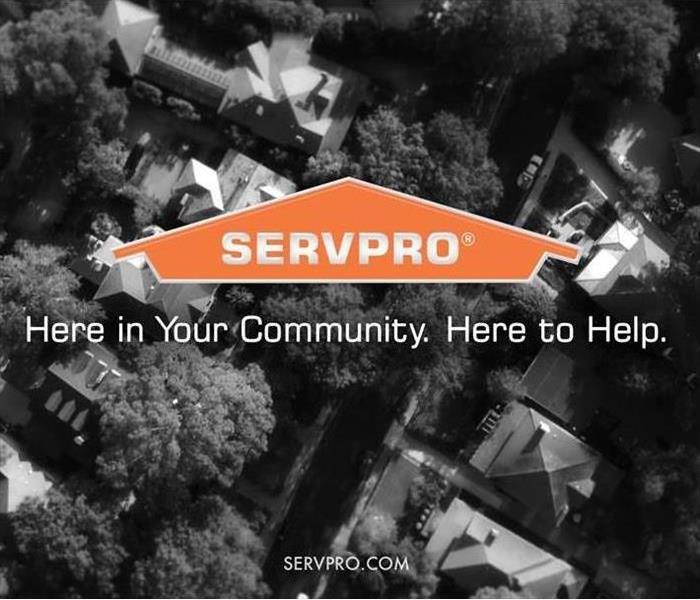 SERVPRO of South Pasadena will be ready to take care of you when the next storm hits.
SERVPRO of South Pasadena will be ready to take care of you when the next storm hits.
SERVPRO of South Pasadena will be ready to take care of you when the next storm hits.
After Hurricane Harvey, thousands of people were sent into a financial panic. Most people did not have flood insurance because their house was not located in what is considered a flood zone. Thanks to FEMA, the Federal Emergency Management Agency, many of these families were able to begin the recovery process. But what now? What does this once every hundred years storm mean for your insurance? You will be surprised.
New Flood Zones
Did the Harvey floodwaters cause over $5,000 in damage to your home? If they did, congratulations, you are now in what is considered to be a flood zone. Even if you have never flooded before this one event was all the insurance companies needed to raise their rates for flood insurance in your area. While it is possible and likely Houston will never experience another Harvey, we can not predict how the rivers and flood zones will change. Hence, causing the caution for all the rise in insurance.
Do You Need Flood Insurance?
There is no easy answer to that question. If you are in a flood zone, many communities will require you to have it. Here at SERVPRO of South Pasadena, we say "You can never have too much insurance. Better safe than sorry." Our recommendation is if you are along the coast or in a flood zone including those formulated after Harvey, purchase flood insurance. If you are outside of a flood zone speak with your agent to calculate the risk and consider putting together an emergency storm fund. If you do deny to purchase flood insurance your agent will need to receive it in writing. Ultimately, the decision is yours.
Either way, SERVPRO of South Pasadena will be ready to take care of you when the next storm hits; And if you do have insurance we are on their vendor list. All you have to do is request us and we will come to take care of you. Experienced a catastrophic weather event?
Have Questions? Call Today – (713) 472-4162
Prevent Your Home from Flooding
3/9/2021 (Permalink)
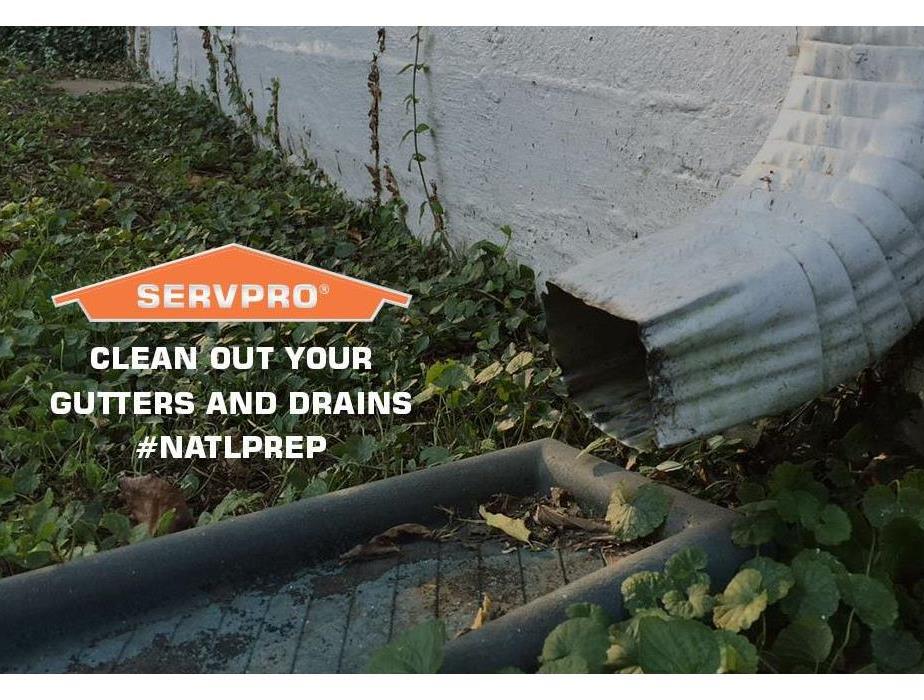 Cleaning your gutters is an effective way to make sure water drains safely from your house and you stay dry.
Cleaning your gutters is an effective way to make sure water drains safely from your house and you stay dry.
Basic Home Maintenance Can Prevent Your Home from Flooding
Of the many issues that can cause flooding in your home or attic, an often-overlooked item is a clogged gutter system. This critical network of water diversion works to send runoff from your roof to areas away from your house's vulnerable foundation but can often get filled with leaves and other debris. When this system fails or does not work as it should, the results could be serious. Learn how to keep your gutters clean and what to do if you experience flooding.
Keeping gutters clean
The gutters surrounding the eaves of your home exist to help prevent instances of flood damage from occurring. Unfortunately, many homeowners do not even know about a problem with this network of channeling until it is full and causing a water backflow or overflow situation to arise. Gutters need to be cleaned at least twice a year – in the spring and in the fall when you’re most likely to experience leaves or needs dropping and clogging up drains. If you have pine trees near your home, needles will need to be removed every three months to reduce the potential for clogging the gutters and downspouts. There are actually a few simple steps to prevent this from happening so you don’t experience a flood in your home. Simply getting up on the roof near your gutters and manually cleaning out the blockage is a good start. Many homeowners will you a power spray or hose with a narrow nozzle to get the blockage you’re unable to get by hand. There are also services that will come out and keep your gutters clean if you prefer not to do it.
Keeping your roof in good condition
The Texas sun can really do a number on your roof. It’s important to keep an eye on it and address any areas of weakness where water may come through. Whether you go up on the roof yourself to inspect or hire a professional to do it, it’s a smart idea to give your roof the once-over at least once a year to prevent water damage from a leaky roof. Depending on what your roof is made of a simple repair could do the trick, or you may need more substantial work.
Keeping good drainage around your home
Some monsoon seasons are more damaging than others. Before you experience a heavy rainstorm, walk around your home to make sure you have good drainage all around your home. If you find water puddling next to your foundation, or see water moving toward your home instead of away, it’s important to fix this so that water doesn’t seep in and cause damage to your home.
What do if you experience water damage
When you find this water making its way into your house, it is time to call in professionals who can handle this situation as efficiently as possible. From the moment that our SERVPRO team arrives at your home, we work to assess what needs to happen to prevent water from continuing to enter your home and allow for extraction and drying to occur successfully. Depending on the severity of the flooding inside of your house, our SERVPRO professionals might only need to use portable pumps to remove the water. Larger quantities of water may require the use of a pump truck. Once the water is removed, we’ll dry the premises and work with any water-damaged items to restore or remove the materials.
If clogged gutters, a leaky roof or poor drainage cause flooding to your home, reach out to our experienced SERVPRO of South Pasadena team of restoration specialists. We can help you remove the water and bring your home back to the way that it should be. Give us a call anytime, 24/7, at (713) 472-4162.
Your Commercial Property: Water Damage Restoration
3/9/2021 (Permalink)
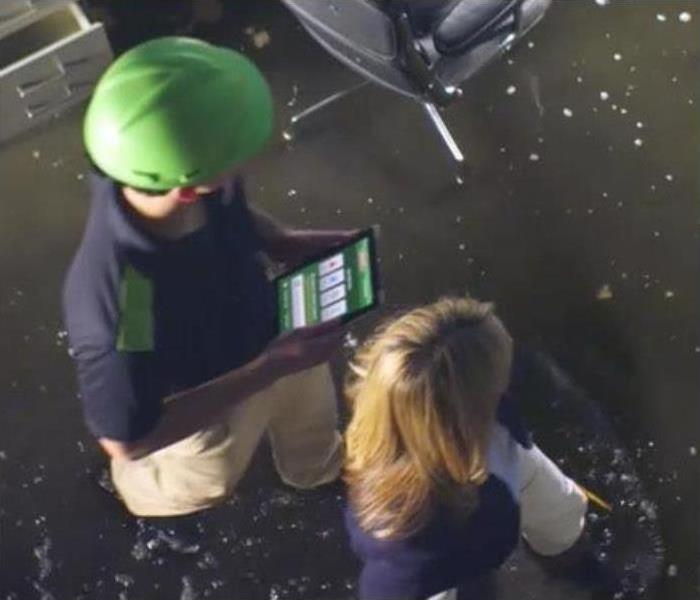 If your commercial property experiences water damage of any kind, contact SERVPRO 24/7 at (713) 472-4162.
If your commercial property experiences water damage of any kind, contact SERVPRO 24/7 at (713) 472-4162.
Unchecked water can be devastating to any structure. Water entering your commercial property risks far more potential extensive damages to stored merchandise, equipment, and shipping materials. Fast action by water remediation specialists like SERVPRO of South Pasadena mitigates damages to commercial structures caused by water or flooding.
Why water damage is so destructive to commercial properties
Keep in mind that water damage to your commercial property is potentially worse than damage found in any other kind of structure. It’s extremely important to understand how to prepare your structure to resist water, or what to do if water damage or flooding occurs. Depending on the type of business it is, flooding at a commercial property can be expensive if numerous computers or other electronics are on site, or the property stores products or goods. Larger properties tend to have more contents; thus, the risk of a higher damage is very possible. As a commercial property owner, you must remain vigilant when it comes to protecting your property against water damage. SERVPRO can help you learn what to look out for and how to react to damages that can cause a slow in productivity or a loss of revenue for your company. Request a consultation with Kimberly Robb, 281-520-8197, concerning the ERP Plan to better prepare you for unexpected mishaps or emergencies.
How damage goes beyond water
Hidden water, high humidity, and condensation often lead to mold contamination on your property. Cracks in your walls, ceilings, flooring, foundation, and roof allow temperature changes that drastically affect stored goods. Left unchecked, this damage can spread and cause significant loss. As with most disasters, being prepared can help prevent losses, or mitigate how extensive those losses are. Mold and lingering odors are unanticipated consequences of unchecked water damage to commercial property and need to be addressed if water damage occurs.
How SERVPRO helps commercial property owners
SERVPRO's IICRC-industry certified technicians can perform a full inspection of your commercial property following water damage or flooding, providing you with the location of possible problems, services to correct these issues, and the preventative steps necessary to prevent reoccurring damages in the future. They will discuss any remediation solutions with you before starting any work so that you’re well aware of what to expect when water remediation services are complete, and what if any reconstruction or restoration services might be necessary. SERVPRO technicians can help steer you in the right direction on how to mitigate future problems and provide you with the personnel, equipment, and resources necessary to recover should extensive water damage exist on your property.
If your commercial property experiences water damage of any kind, contact SERVPRO of South Pasadena 24/7 at (713) 472-4162. We can help you take the stress out of your current situation and keep you informed throughout the restoration process to make things easier.
Storm Readiness
10/15/2020 (Permalink)
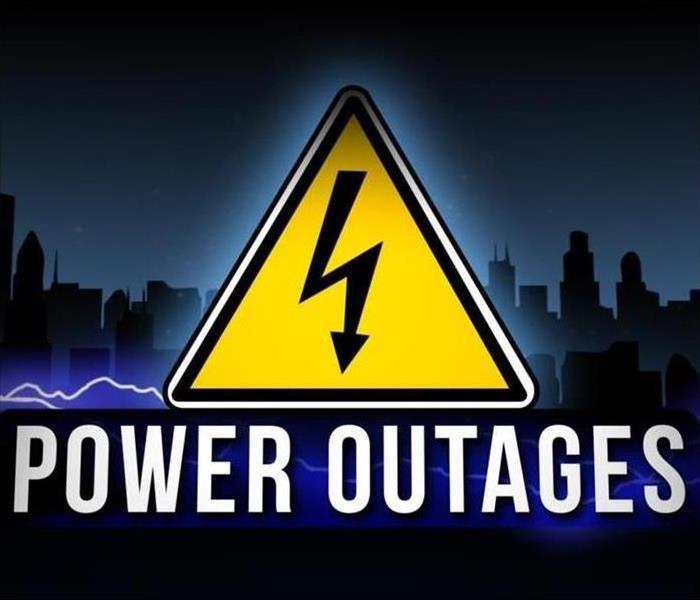 Be Ready!
Be Ready!
How do you prepare for a power outage?
Whether it’s stocking up on nonperishable supplies or formulating a plan of action with the rest of the family, there are numerous ways homeowners can ensure they’re ready. One of the steps you may not have considered, however, is to schedule an inspection with a local water and storm damage restoration company. If you’re curious to learn more about power outage preparedness and what you can do, talk with the experts at SERVPRO of South Pasadena. They specialize in storm damage restoration services and will be happy to supply the assistance you’re looking for.
Besides ensuring your home is structurally sound, the water damage restoration experts also recommend the following three tips for power outage preparedness:
- Create an Emergency Kit: Always have an emergency kit on hand. This should include first aid supplies, light blankets, flashlights, water bottles, energy bars, and other nonperishable essentials to help you survive several hours without electricity.
- Fill the Gas Tank: Don’t be left stranded with no transportation. Since gas pumps function on electricity, it’s a good idea to fill your vehicle’s tank at least half full, so you can get the entire family to a safe place if need be.
- Purchase a Generator: If you have appliances or equipment that shouldn’t be without electricity for long periods, then you should consider purchasing a generator. It shouldn’t have to provide electricity for the entire house, but it should have enough power to sustain those few pieces of equipment.
Discover how you can be better prepared for the next power outage by contacting SERVPRO of South Pasadena. They are knowledgeable about storm damages! One of the knowledgeable staff members at SERVPRO of South Pasadena will be available to answer any questions you may have. Visit their website for additional information about their carpet cleaning and storm damage restoration services.
Hurricane Season is Here! Who Do You Call for Help?
9/4/2020 (Permalink)
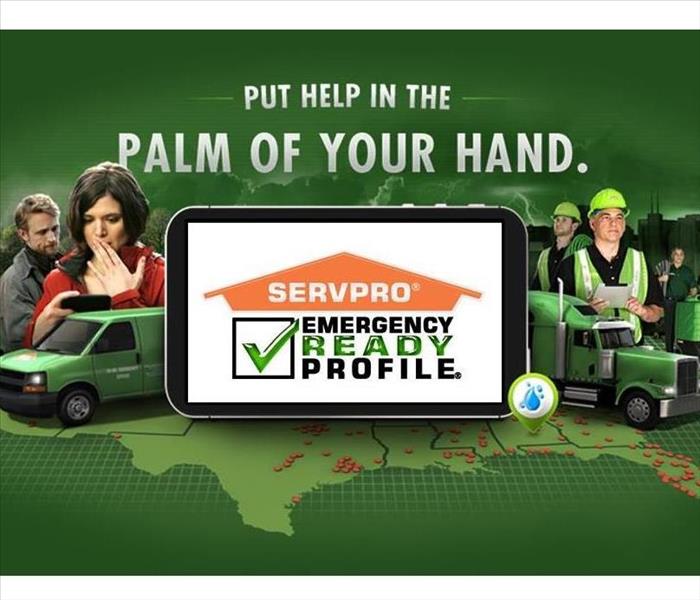 Give me a call to schedule a ERP for your building or commercial clients!
Give me a call to schedule a ERP for your building or commercial clients!
Who Do You Call for Help?
We are prepared and ready. In the event of anyone needing our help, please call Kimberly Robb at 281-520-8197 for immediate assistance or our office at (713) 472-4162.
Be sure everyone in your office has my number saved in their phone!
The Best Way to Reduce Business Interruption Following a Disaster is to Plan For it NOW!
As many as 50% of businesses may never recover following a disaster, according to the latest industry research. Of the businesses that survive, the overwhelming majority of them had a preparedness plan in place. Pre-planning can serve as an insurance policy aimed at peace of mind. By developing a SERVPRO® Emergency READY Profile, business interruption is minimized by having an immediate plan of action. Knowing what to do and what to expect in advance is the key to timely mitigation and can help minimize how water and fire damage can affect your customers' businesses.
Are You Ready?
The best time for planning for such events is not when the event happens, but well before it happens. No one ever plans ON a disaster, but you can plan FOR it. Now is the time to ask yourself, “Are you ready for whatever could happen?” The SERVPRO® Emergency READY Profile is a start up approach that provides the critical information needed to begin mitigation and recovery services. It is designed to serve as a quick reference of important building and contact information. I can help you quickly get your property back in working order. Give me a call to schedule a ERP for your building or commercial clients! Thank you, Kimberly Robb
SERVPRO® of Friendswood/Pearland SERVPRO® of South Pasadena Marketing & Sales Manager Sr. Commercial Project Manager Kimberly@SERVPROpearland.com Mobile – 281-520-8197
Tips for Hurricane Preparedness
6/12/2020 (Permalink)
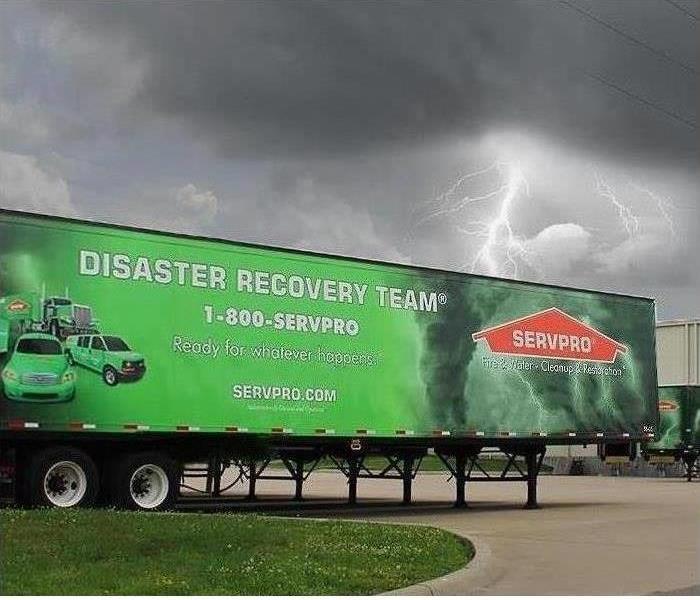 For help with storm damage, call the office team with SERVPRO® South Pasadena.
For help with storm damage, call the office team with SERVPRO® South Pasadena.
If you live near the coast, you probably cringe at the thought of Hurricane Season. No worries, your friends at SERVPRO® of South Pasadena are here with some helpful tips to keep your family and home prepared!
10 Tips for Hurricane Preparedness:
- Build or buy a disaster supply kit. Your kit should contain water (Rule of Thumb: 2 gallons per person, per day for at least 3-4 days), at least a 3 day supply of non-perishable foods, a can-opener, a first aid kit, flashlights/candles, crank radio, flare guns or whistles to signal for help, extra clothes, cash, a local map, and any specialty items for infants, elderly, or disabled family members.
- Create an evacuation plan. If your family is not together at the time of the emergency, where is a safe, accessible area for everyone to meet? Where will you go? What do you need to bring with you? What is the best route to avoid traffic? Make sure all family members are aware of your evacuation plan and assign tasks to each family member to help get your family out of harm's way as quickly as possible.
- Fill your bathtubs with water. This water can be used to flush toilets, cleaning and washing. Keep a bucket or other large container for scooping the water you need.
- Make a list of emergency contacts. This would include your family physician, insurance agent, key family members, and of course, your friendly neighborhood SERVPRO®!
- If you do not plan on evacuating, board your windows and other openings with plywood. This provides protection in the instance your window is broken during the storm and from any flying debris.
- Place sandbags in any areas you would like to prevent water intrusion. Your home’s garage is the most vulnerable area against wind and water. Placing sandbags at your garage doors and any other vulnerable areas will help keep the damage at a minimum.
- Secure any outdoor furniture or toys that could get blown around or float away. If you have a pool, you can toss any water-friendly toys or patio furniture into the pool. Once the items are under water in the pool, they won’t be able to float out or blow away. This practice is commonly used by hotels to prevent their pool-side furniture from being lost in the storm. If you do not have a pool, move the outdoors items into the garage or under a tarp that is anchored to a secure spot.
- Turn your refrigerator and freezer on the coldest setting. This should help keep the food cold during a power outage. Should your power go out, avoid opening the refrigerator if you can. If you must open it- open it quickly, grab what you need, and close it immediately.
- Place valuables or items that can easily be ruined by water into containers and on higher ground. Remove anything from the floor, bottom cabinets/shelves, and furniture that could get ruined by the flood waters and stack them on something off the ground, such as a bed or table.
- Know who you need to call in the instance you’ve had a loss at your property and need to make a claim. Keep your insurance agent and adjuster information stored or written down in your disaster kit. Calling your agent or adjuster’s direct line VS the 1-800 number can lead to a quicker response.
For help with storm damage, call the office team with SERVPRO® South Pasadena at (713) 472-4162, or visit out website: https://www.SERVPROsouthpasadena.com/
Hurricane Season Is Here
5/19/2020 (Permalink)
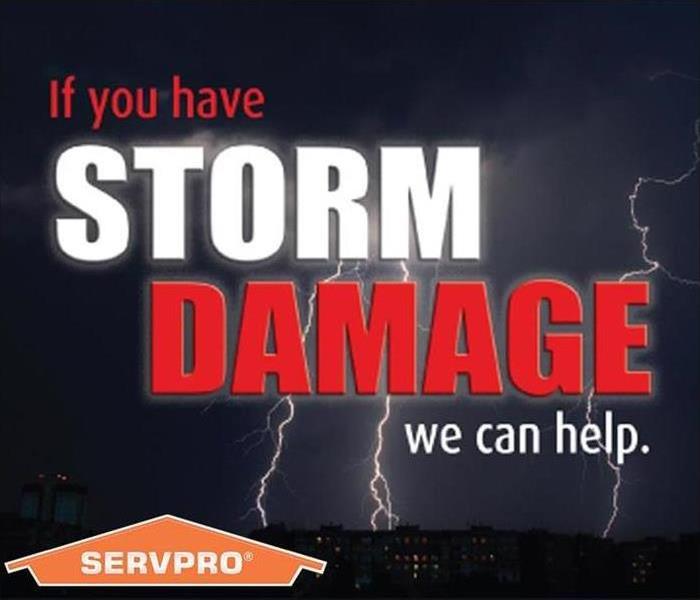 When you have water damage, don't leave your property to chance.
We Answer the Phone Ready to Help
When you have water damage, don't leave your property to chance.
We Answer the Phone Ready to Help
Hurricanes can be life-threatening as well as cause serious property-threatening hazards such as flooding, storm surge, high winds, and tornadoes. While the primary threat is in coastal areas, many inland areas can also be affected by these hazards, as well as by secondary events such as power outages as a result of high winds and landslides due to rainfall.
Preparation is the best protection against the dangers of a hurricane. Plan an evacuation route and your emergency plan, take inventory of your property, and take steps to protect your home or business. For more information and preparation tips, visit the Ready campaign website at www.ready.gov/hurricanes.
When you have water damage, don't leave your property to chance.
We Answer the Phone Ready to Help
Call Today -
Kimberly Robb, (281) 520-8197, spkimberly1@gmail.com
Catalina Cardenas, (281) 520-8196, spcatalina1@gmail.com
https://www.SERVPROsouthpasadena.com/
Storm Team
5/5/2020 (Permalink)
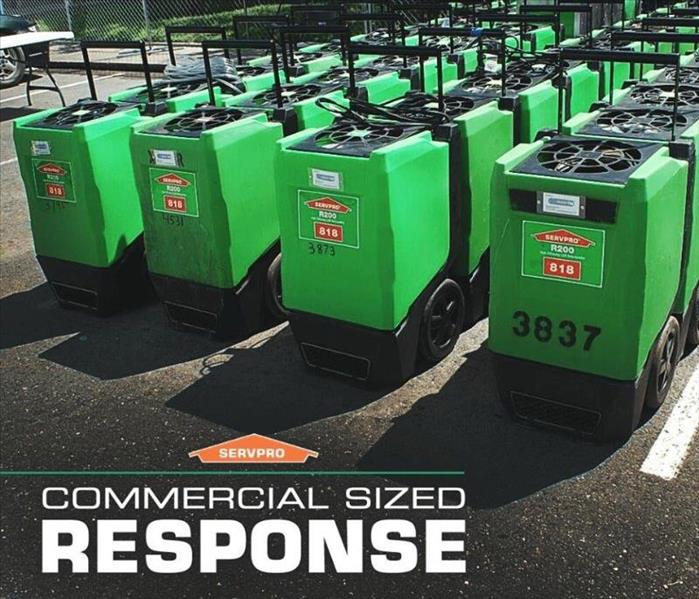 These Storm Sites are committed to being in a constant state of readiness.
These Storm Sites are committed to being in a constant state of readiness.
What Is STORM?
A controlled response managed by one or more SERVPRO® Storm Sites which are operated by one of four Franchise owned teams. These Storm Sites are committed to being in a constant state of readiness. Always answering the call and mobilizing to service National Accounts clients’ customers. Always willing to assist the Local Franchises in servicing spikes in volume for which they have difficulty getting to all customers in a timely fashion.
How Does It Affect You?
The Storm Response Program maximizes production volume as a result of weather and catastrophic events. Through the four Franchise owned Storm Teams the program is capable of scaling to manage catastrophic events from a local microburst that provides only a few opportunities serviced by regional Franchises, up to large hurricanes that provide thousands of opportunities and require hundreds of crews.
How Do We Do It?
- Promote and Plan
- Monitor the Potential Event
- Activate the Event
- Execute the Event
- Exit the Event
- Post Event
No Job Is Too Large
5/5/2020 (Permalink)
No Job Is Too Large
The SERVPRO Commercial Large Loss Division is composed of our best of the best in restoration. Our elite large-loss specialists are prequalified and strategically positioned throughout the United States to handle any size disaster.
Every large loss is supervised by a commercial operations manager to help ensure seamless communication and timely mitigation.
At SERVPRO, the difference is our ability to dispatch trained production professionals and cut costs through the strategic placement and oversight of temporary labor. Get the professionals, call SERVPRO.
Clients for the Commercial Large Loss program include the following:
- The Hospitality Industry
- Property Managers
- Universities
- Municipalities
- The Pentagon
We follow industry approved standards for the level of dry, which often means most homes will achieve a dry stage in three to five days, while larger flood or commercial sites may take longer.
We Answer the Phone Ready to Help
Call Today -
Storm Team
5/5/2020 (Permalink)
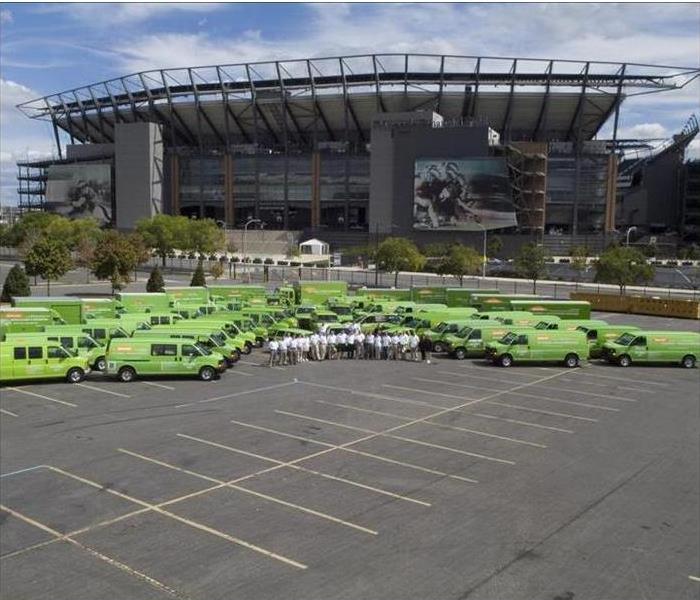 These Storm Sites are committed to being in a constant state of readiness.
These Storm Sites are committed to being in a constant state of readiness.
What Is STORM?
A controlled response managed by one or more SERVPRO® Storm Sites which are operated by one of four Franchise owned teams. These Storm Sites are committed to being in a constant state of readiness. Always answering the call and mobilizing to service National Accounts clients’ customers. Always willing to assist the Local Franchises in servicing spikes in volume for which they have difficulty getting to all customers in a timely fashion.
How Does It Affect You?
The Storm Response Program maximizes production volume as a result of weather and catastrophic events. Through the four Franchise owned Storm Teams the program is capable of scaling to manage catastrophic events from a local microburst that provides only a few opportunities serviced by regional Franchises, up to large hurricanes that provide thousands of opportunities and require hundreds of crews.
How Do We Do It?
- Promote and Plan
- Monitor the Potential Event
- Activate the Event
- Execute the Event
- Exit the Event
- Post Event
Immediate Storm Damage Cleanup
1/22/2020 (Permalink)
Storm damage can often have layers of destructive effects that must get addressed immediately to protect as much of your property as possible. Your flooring and carpeting can often be among the most challenging to address. Our SERVPRO of South Pasadena professional technicians can work to begin extraction and drying of damaged areas when we arrive. We work around the clock to prevent unnecessary secondary damage.
Our contents department will be able to determine what items and personal belongings are salvable and if we need to do a pack out to ensure your belongings are safe during the restoration process. With our team of qualified restoration technicians with accreditation's from the Institute of Inspection Cleaning and Restoration Certification (IICRC), we offer focused cleaning, drying, and storage of these items in our climate-controlled facility.
Flooding can be a nightmare in your home or business and the effects only get worse the longer you wait. Give SERVPRO of South Pasadena a call at (713) 472-4162 to make your loss incident “Like it never even happened.”
If a Disaster Strikes, Will You Be Ready?
1/22/2020 (Permalink)
It is important to prepare before a storm or disaster occurs. Consider the following steps to better prepare for an emergency situation:
- Sign up for local alerts and warnings, download apps, and/or check access for wireless emergency alerts.
- Develop and test emergency communication plans with your family.
- Assemble or update your emergency supplies.
- Learn about local hazards in our Pasadena City, and conduct drills to practice emergency response actions.
- Participate in a preparedness discussion, training, or class.
- Collect and safeguard critical documents.
- Plan with neighbors to help each other and share resources.
- Document property and obtain appropriate insurance for relevant hazards.
- Make property improvements to reduce potential injury and property damage.
Emergencies and storms can happen anytime to anyone. Taking action now helps to protect not only yourself, but also your property.
When a pipe bursts in your home.
12/30/2019 (Permalink)
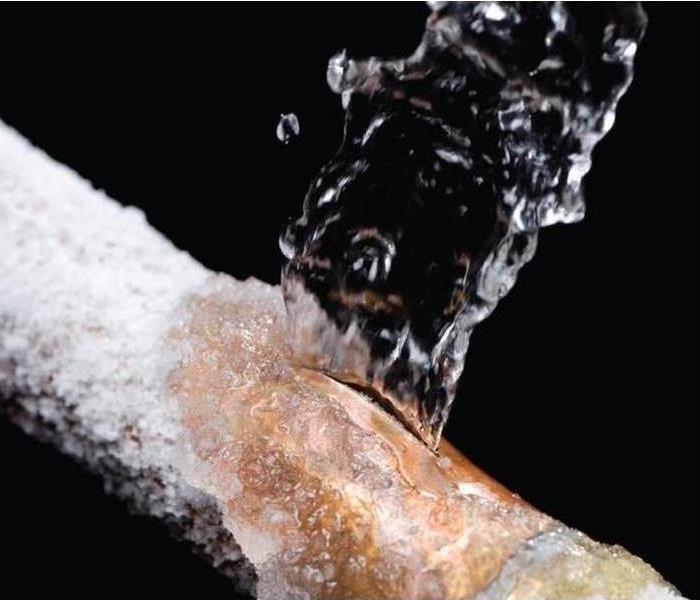 A burst pipe can cause serious water damage.
A burst pipe can cause serious water damage.
Here in Texas we don't have a many freezing nights. When it does happens, outside homes are at risk of burst pipes and all the headaches and water damage they bring. A burst pipe can happen almost anywhere, but usually occurs with pipes that are close to the exterior of your home.
The most critical aspect of dealing with a burst pipe is turning off the water supply and stopping the flow of water. Water in a crawlspace or basement is usually well contained and can be easily dried out. However, when a pipe bursts in the main part of your home, such as a toilet feed or an under-sink supply line, it can create a much bigger mess depending upon how much water has inundated the house.
When a pipe in your home bursts—affecting multiple rooms—travels from an upper level to a lower level of the home, or has been left unnoticed for more than 8 hours, professional water mitigation and specialized drying equipment is essential for preventing long-term damage. If you see that water has seeped into the subflooring or the drywall the safest step would be to contact a professional water damage remediation company like SERVPRO of South Pasadena to help remove or restore items that would otherwise be destroyed by mold.
We Will Be There in Your Time of Need
10/25/2019 (Permalink)
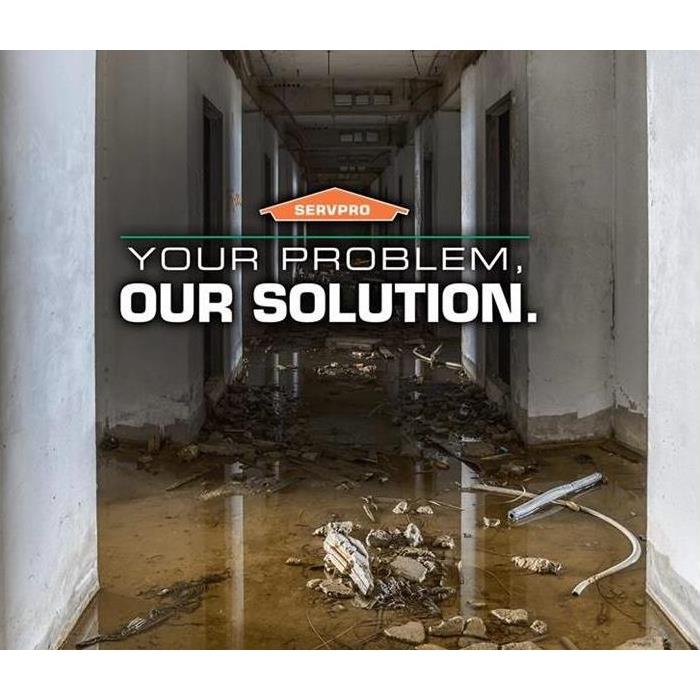 We Are Faster To Any Disaster!
We Are Faster To Any Disaster!
Storms are often very unpredictable, as well as the damage they may cause in their wake. Here at SERVPRO of South Pasadena we take pride in providing 24/7 emergency services to help. Whether the storm causes water damages from a roof leak or wind-driven rain, our technicians are trained to handle any situation. No matter the disaster, we're here to help you restore your home. We strive to make the process as simple and easy as possible to put your mind at ease. Our crew understands the stress that comes when you experience a disaster. We will be by your side every step of the way. Whether its flooding or a fire caused by a lightning strike, you can count on SERVPRO of South Pasadena to be there for all your needs.
CALL US TODAY: 713-472-4162
Hurricane Harvey Final Facts
1/29/2019 (Permalink)
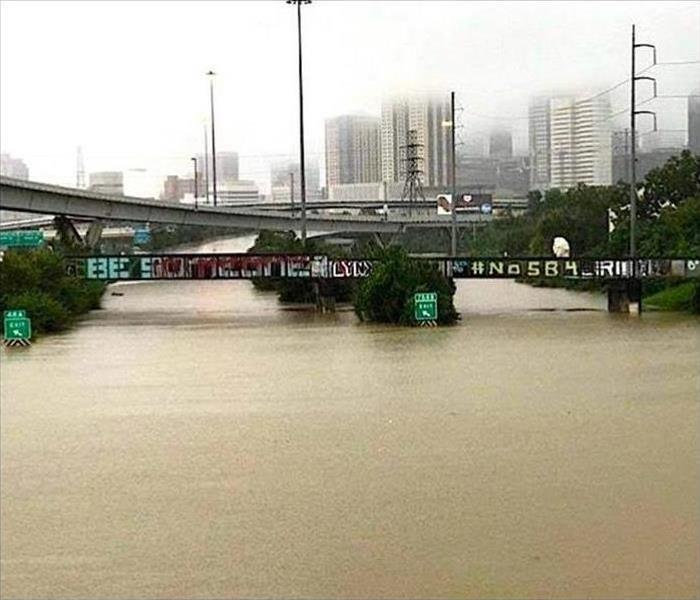 The 'Be Someone' graffiti is one of the most memorable landmarks of Houston. It sits above I-45 near downtown.
The 'Be Someone' graffiti is one of the most memorable landmarks of Houston. It sits above I-45 near downtown.
Hurricane Harvey
Category 4
August 17- September 2, 2017
- 82 confirmed deaths
- Harvey was the first major hurricane to hit the US since Wilma (2005)
- Was the first Category 4 Hurricane in Texas since Carla (1961)
- Over 200,000 homes were damaged or destroyed
- 738,000 people registered with FEMA
- More than $378 million dollars have been paid out
- The Hurricane caused $125 billion in damage
- The first point of landfall was August 25 in south-central Texas
- Only 20% of homes hit had flood insurance, leaving the other 80% left without coverage
- Some areas were recorded getting up to 51 inches of rain
- The highest wind speed recorded was 134 mph
- Texans Football Player J.J Watt raised a staggering $37 million in relief funds for Harvey
Facts and information credited to:
Amadeo, Kimberly. “Hurricane Harvey Shows How Climate Change Can Impact the Economy.” The Balance, www.thebalance.com/hurricane-harvey-facts-damage-costs-4150087.
“Hurricane Harvey Aftermath.” Www.cnn.com, www.cnn.com/specials/us/hurricane-harvey.
“Hurricane Harvey: Facts, FAQs, and How to Help.” World Vision, 11 Dec. 2017, www.worldvision.org/disaster-relief-news-stories/hurricane-harvey-facts.
SERVPROS STORM Response
1/29/2019 (Permalink)
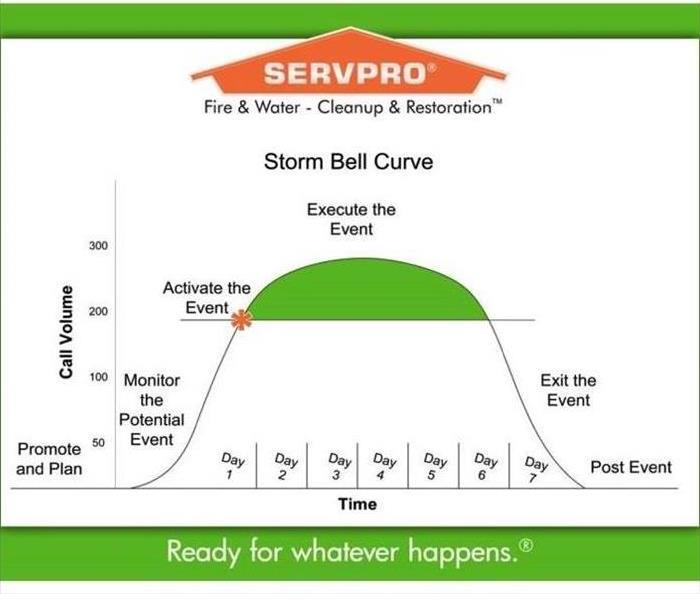 This is a chart providing a quick look at the timeline of a STORM response
This is a chart providing a quick look at the timeline of a STORM response
What Is STORM?
A controlled response managed by one or more SERVPRO® Storm Sites which are operated by one of four Franchise owned teams. These Storm Sites are committed to being in a constant state of readiness. Always answering the call and mobilizing to service National Accounts clients’ customers. Always willing to assist the Local Franchises in servicing spikes in volume for which they have difficulty getting to all customers in a timely fashion.
How Does It Affect You?
The Storm Response Program maximizes production volume as a result of weather and catastrophic events. Through the four Franchise owned Storm Teams the program is capable of scaling to manage catastrophic events from a local microburst that provides only a few opportunities serviced by regional Franchises, up to large hurricanes that provide thousands of opportunities and require hundreds of crews.
How Do We Do It?
- Promote and Plan
- Monitor the Potential Event
- Activate the Event
- Execute the Event
- Exit the Event
- Post Event
Hurricane Preparedness
12/26/2018 (Permalink)
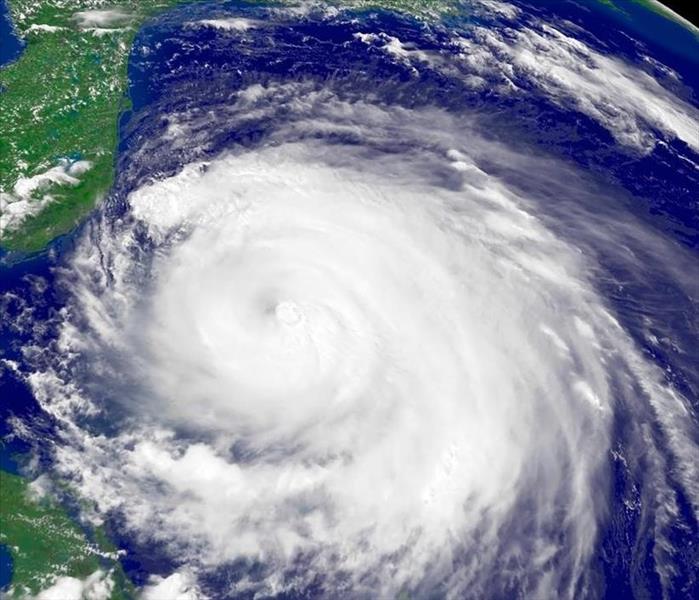 Are you ready?
Are you ready?
Hurricane Season starts June 1st, get prepared now!
Living in or near a coastal county, you’re most likely already accustomed to stalking the weather channel during Hurricane Season. The more you can prepare ahead of time, the less frustration you’ll have in the event a hurricane threatens the Gulf Coast. And, you will thank yourself later, I promise.
Follow these 4 Steps for successful Hurricane Preparedness.
- Start putting together a disaster supply kit now. Getting a jump on this will help prevent a last-minute run to the store only to find empty shelves, and you can save yourself from incurring the expense all at once. Get a medium-sized plastic, sealable container to keep everything dry and together. Include a flashlight (or few), extra batteries, cash, first aid supplies, water, portable chargers (fully charged), an extra pair of contacts (if needed) and copies of your critical information if you need to evacuate.
- Create an evacuation plan. In the event your area is ordered to evacuate, having a plan in place will save you a lot of stress. Know the local hurricane route(s) and have a plan for where to stay. Make sure your plan includes supplies you may need while you’re traveling. Traffic on hurricane evacuation routes can seriously delay normal travel times, so be sure to have plenty of snacks and drinks for the kiddos and pets. Also, consider packing a small “entertainment box” in advance for each child, stuffed with their favorite (quiet) activities. Including something new, such as a travel game or new movie can help curb boredom. You’ll want to keep them as entertained as possible. You might also want to throw a roll or two of toilet paper in your disaster supply kit (trust me on this one). An extra gas can (full, of course) won’t hurt either.
- Stock up on supplies. If you are not in an area that is advised to evacuate and you plan to weather the storm in place, be sure you have adequate supplies. Make sure your portable generator is working, and you have plenty of gas on-hand. You may lose power and water for several days and you may not be able to leave due to flooding. Have a one-week supply of non-perishable food and water for each person. Don’t forget to get those prescriptions filled, also. If you have infants, stock up on diapers, wipes, and formula.
- Prepare your home. Have the proper plywood, steel or aluminum panels to board up the windows and doors. Remember, the garage door is the most vulnerable part of the home, so it must be able to withstand the winds. Secure loose rain gutters and clear them of debris. Also, bring in any outdoor furniture or toys that could get tossed around, damaging your, or even your neighbor’s, home. Turn your refrigerator and freezer to their coldest settings and use a cooler when possible to keep food cold during a power outage. Fill your bathtub(s) with water for use in flushing toilets, especially crucial for those who have septic systems when the power goes out.
If your home suffers storm damage during Hurricane Season, count on the professionals at SERVPRO of S. Pasadena to restore your property to pre-disaster condition. "Like it never even happened." Please call Kimberly at 281-520-8197 any time of the day or night for assistance.
Hurricane Michael in Panama City Florida
11/20/2018 (Permalink)
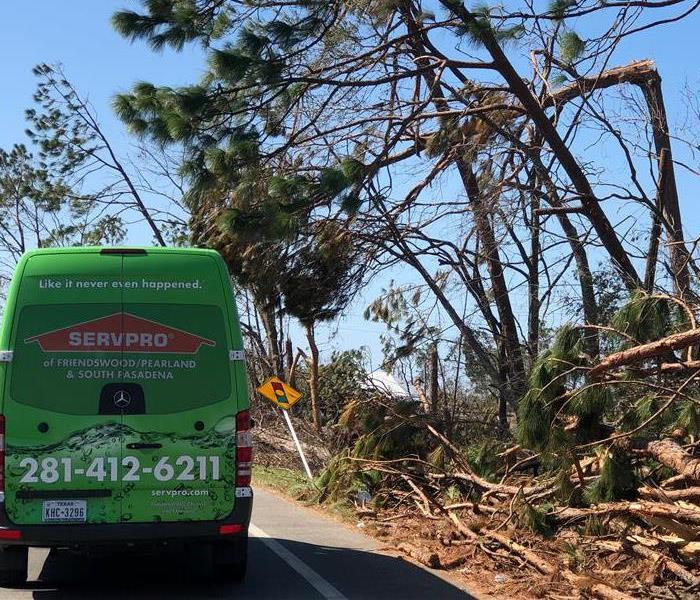 Heading to meet with a customer after the storm.
Heading to meet with a customer after the storm.
Storm and flood damage can be devastating. Immediate action is needed, and you need the company with storm damage experience. SERVPRO Franchise Professionals have the expertise and the resources to handle any size disaster and can respond immediately to storm and flooding conditions.
There is no job too big or too small for SERVPRO of South Pasadena. The storm hit and caused a tremendous amount of wind and water damage. After getting the news, we loaded up and headed to the heavily affected areas in Florida. Over the course of our stay, we were able to help several families who were in desperate need of our help. Whenever you are in need, we will always be there. You can give us a call (281)-412-6211.
Pretend a Storm is Coming Now
10/18/2018 (Permalink)
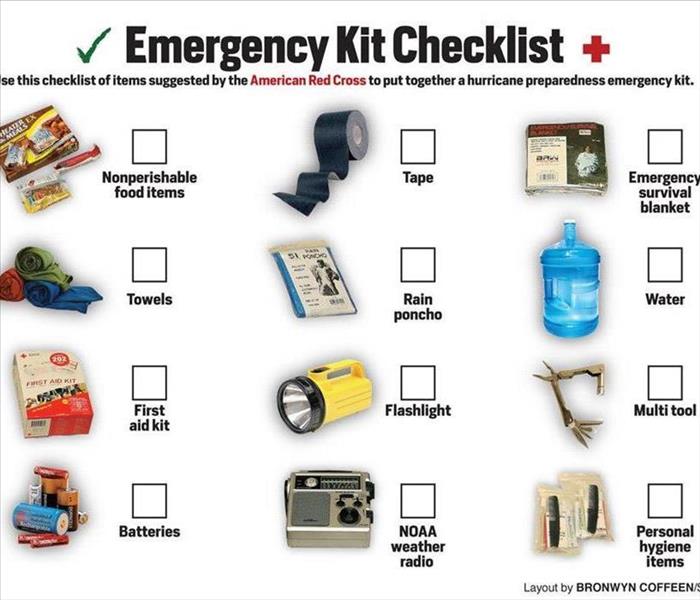 Preparation is the best protection against the dangers of a hurricane.
Preparation is the best protection against the dangers of a hurricane.
Don’t wait until you hear a hurricane, tornado or thunderstorm of the century is coming. There are plenty of storm preparation checklists and common-sense advice out there for storm preparation. Take care of the things you can now, so you don’t have to be scrambling at the last minute.
Whether you need emergency flood damage restoration or top-to-bottom home cleaning, you can trust SERVPRO South Pasadena Professionals to make your house feel like home again. They have the training, experience, and equipment to quickly get your home looking its best. Our residential services include the following:
If you have questions, give our office a call and we will be glad to help.
281-412-8197
Be Financially Prepared
10/18/2018 (Permalink)
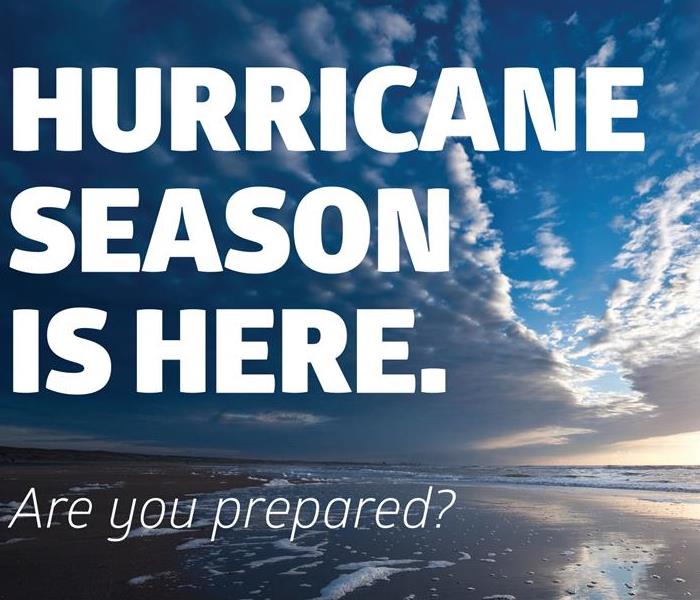 How Do I Buy Flood Insurance?
How Do I Buy Flood Insurance?
Please make sure you have adequate insurance coverage, especially if you live in a storm-prone geographic area. You might also consider creating an emergency fund, which is always a good practice generally, but it’s especially important to have extra resources on hand in the event of a natural disaster. You never know when you will have to evacuate and travel and leave your home.
Start making an emergency plan with your family, friends and household by discussing the types of disasters that could strike and what to do at different times of the day. Discuss how to prepare and respond to emergencies that are most likely to happen where you live, learn, work, and play. Keep your emergency plan as simple as possible and use places that are very familiar and hard to forget. Identify responsibilities for each member of your household and plan to work together as a team. SERVPRO of South Pasadena is here to help. Give us a call 281-412-6211.
Storm-Proof Your Home
10/17/2018 (Permalink)
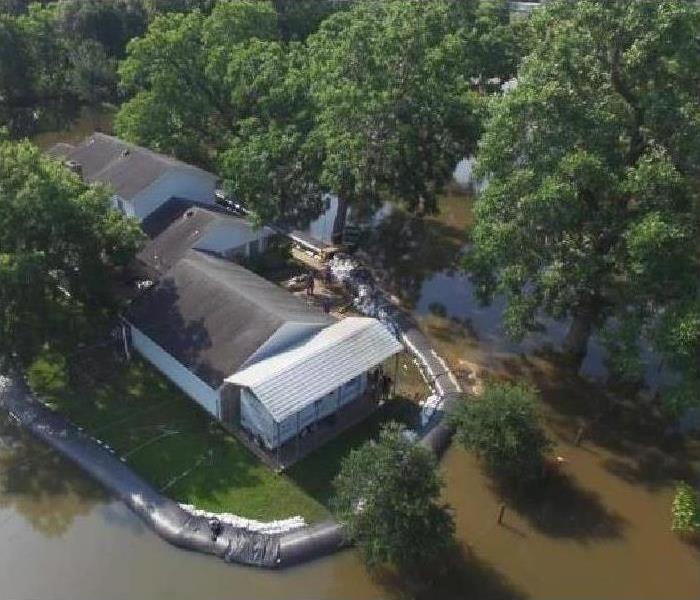 Creating the right barrier can protect your home even in extreme situations like the one above. This personal dam could set you back $10,000!
Creating the right barrier can protect your home even in extreme situations like the one above. This personal dam could set you back $10,000!
So a Tropical Depression has made its way into the Gulf of Mexico. Chances are, you are not going to evacuate. Most Houstonians will choose to ride out a storm as long as it is classified below a Hurricane. Even then a category 1 Hurricane doesn't spark enough fear to cause mass evacuations. If you do plan on riding out the storm here is a checklist you should perform to protect your property before hunkering down.
Property Checklist
- Visual Inspection of your roof. Make sure there are no holes and places where water will enter your home.
- Nail sheets of plywood over every window to protect it from flying debris.
- Trim any loose branches nearby.
- Bring any potted plants or loose objects inside lest they come flying through your window!
- Call your insurance company to make sure you are covered in case you do suffer storm damage. SERVPRO of South Pasadena recommends you do this before Hurricane seasons starts, as it usually takes a few months for your policy to go into effect.
- Do a video walkthrough of your home. This has become more popular in recent years with the surge of technology and it is a fantastic way to keep a record of your personal contents for the insurance companies.
- Lock down your Garage door. If your garage gives way your entire house instantly becomes at high risk for wind or water damage.
- Line all exterior doors to keep rising water from entering your home.
Do you have any other tips for protecting your home during a storm? Message us on Facebook!
Is Houston a Flood Zone?
10/17/2018 (Permalink)
 This picture shows how deep floodwaters got along the Sam Houston Tollway. No wonder people were able to drive boats through the tollbooths!
This picture shows how deep floodwaters got along the Sam Houston Tollway. No wonder people were able to drive boats through the tollbooths!
After Hurricane Harvey, thousands of people were sent into a financial panic. Most people did not have flood insurance because their house was not located in what is considered a flood zone. Thanks to FEMA, the Federal Emergency Management Agency, many of these families were able to begin the recovery process. But what now? What does this once every hundred years storm mean for your insurance? You will be surprised.
New Flood Zones
Did the Harvey floodwaters cause over $5,000 in damage to your home? If they did, congratulations, you are now in what is considered to be a flood zone. Even if you have never flooded before this one event was all the insurance companies needed to raise their rates for flood insurance in your area. While it is possible and likely Houston will never experience another Harvey, we can not predict how the rivers and flood zones will change. Hence, causing the caution for all the rise in insurance.
Do You Need Flood Insurance?
There is no easy answer to that question. If you are in a flood zone, many communities will require you to have it. Here at SERVPRO of South Pasadena, we say "You can never have too much insurance. Better safe than sorry." Our recommendation is if you are along the coast or in a flood zone including those formulated after Harvey, purchase flood insurance. If you are outside of a flood zone speak with your agent to calculate the risk and consider putting together an emergency storm fund. If you do deny to purchase flood insurance your agent will need to receive it in writing. Ultimately, the decision is yours.
Either way, SERVPRO of South Pasadena will be ready to take care of you when the next storm hits; And if you do have insurance we are on their vendor list. All you have to do is request us and we will come to take care of you. Experienced a catastrophic weather event? Call us at 281-412-6211.
Birth of a Hurricane
9/7/2018 (Permalink)
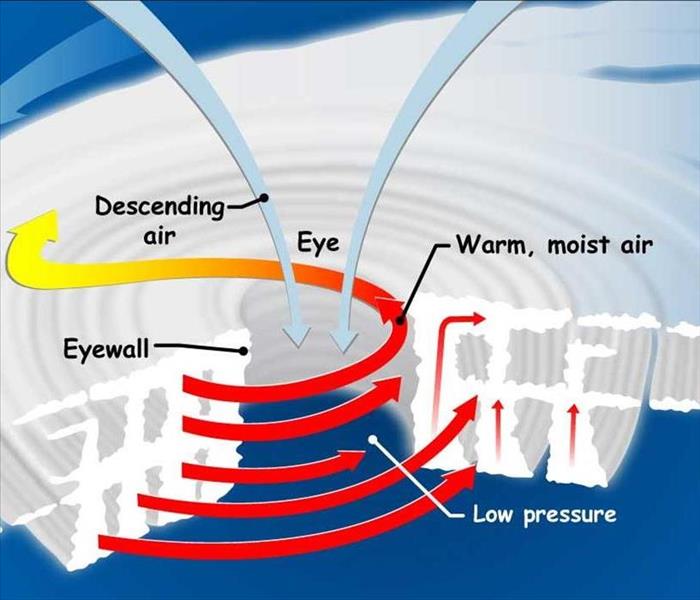 To be classified as a Hurricane the storm must sustain an average wind speed of 74mph.
To be classified as a Hurricane the storm must sustain an average wind speed of 74mph.
Given the right conditions, a small storm can quickly grow into a hurricane. All it takes is water above 79°F, The meeting of a low and high-pressure system, and no land to impede the process.
The Majority of Hurricanes begin as small thunderstorms near the west coast of Africa. As they continue to move westward into the Atlantic, warm moisture is picked up and fuels the growing storm. Over time, the small thunderstorms will merge together to become one large mass.
Earths rotation causes these growing storms to rotate counterclockwise, known as The Coriolis Effect. To get this spin the storm will also need to have a high-pressure system on top and a low-pressure system on the bottom. This is similar to how a tornado forms.
Both Tornadoes and Hurricanes share many similar traits such as an eye and an eyewall. The eye, the center of the storm, is typically clear of any rain or clouds. This is because it is the strongest point where the high pressure and low-pressure systems move between one another. The cool air is warmed by the sun, rises, cools in the high atmosphere, falls, and the cycle starts over once again. Structurally speaking, a Tornado is a compact mini-Hurricane.
Once the Hurricane makes landfall, it unleashes all the energy it had been storing from the open ocean. Without its fuel source, it will continue to weaken back into a small cluster of thunderstorms and eventually dissipate altogether.
To learn more about how hurricanes form you can click this link.
Basic Weather Alert Definitions
6/18/2018 (Permalink)
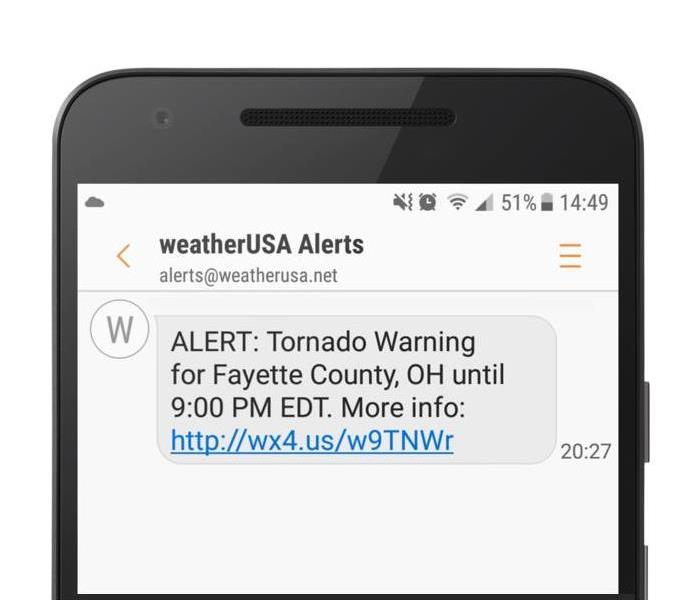 Wireless Emergency Alerts (WEA) are emergency messages sent by authorized government alerting authorities through your mobile carrier.
Wireless Emergency Alerts (WEA) are emergency messages sent by authorized government alerting authorities through your mobile carrier.
It has happened to most of us at some point, you are either playing on your phone or watching television when suddenly you are interrupted by a pop-up followed with a loud, repetitive, beeping noise. The words WEATHER ALERT show up on screen. To some this causes panic and to others the alert is brushed off. But what is the correct response to the weather alerts that so abrasively interrupt your daily activities? The answer lies in the information that comes with the weather alert. Here are some of the most common terms you will see used.
Warning
A warning is issued when a hazardous weather or hydrologic event is occurring, imminent or likely. A warning means weather conditions pose a threat to life or property. People in the path of the storm need to take protective action.
Watch
A watch is used when the risk of a hazardous weather or hydrologic event has increased significantly, but its occurrence, location or timing is still uncertain. It is intended to provide enough lead time so those who need to set their plans in motion can do so. A watch means that hazardous weather is possible. People should have a plan of action in case a storm threatens and they should listen for later information and possible warnings especially when planning travel or outdoor activities.
Advisory
An advisory is issued when a hazardous weather or hydrologic event is occurring, imminent or likely. Advisories are for less serious conditions than warnings, that cause significant inconvenience and if caution is not exercised, could lead to situations that may threaten life or property.
What Determines the Categories of a Hurricane?
6/15/2018 (Permalink)
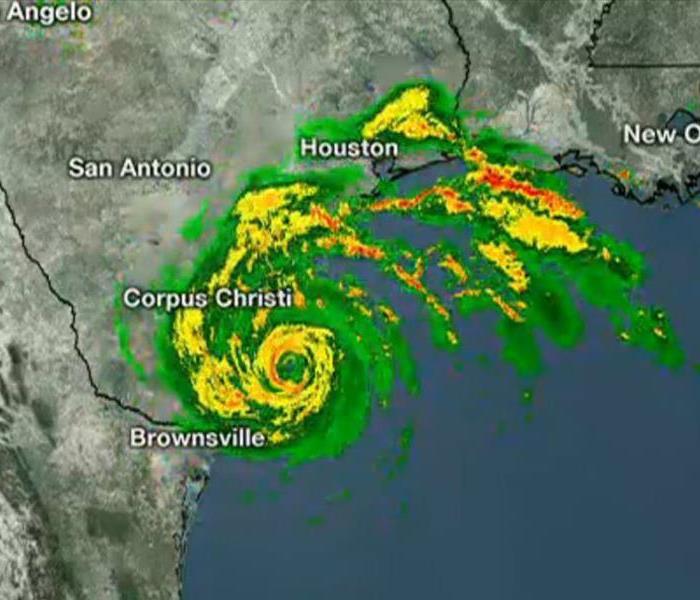 Did You Know a Hurricane will always spin Clockwise?
Did You Know a Hurricane will always spin Clockwise?
If you turn on the television there is one word that is assured to get your attention, especially if you live along the gulf coast. That word, is Hurricane. But if you are like most Houstonians you will not evacuate upon hearing about a Hurricane in the Gulf unless it has been ranked to at least a Category 3. It is true that Category 3 Hurricanes will cause extensive damage, but that does not mean Category 1 and 2 Hurricanes are any less dangerous. In fact, given certain circumstances, a Category 2 Hurricane can do as much damage as a Category 4. So why do we rank Hurricanes and how? The Saffir-Simpson Hurricane Wind Scale This is the official name of the scale used to categorize hurricane in the Pacific. Developed in 1971, this scale was developed by Herbert Saffir and Robert Simpson. To put it in the simplest terms, it ranks Hurricanes by their top recorded wind speeds. However wind is not the only thing that may cause damage. The amount of rain and the strength of the storm surge are not taken into effect. Hurricane Sandy, a category 3 storm, and Hurricane Wilma, a category 5 storm were both devastating to the regions they hit. Yet Hurricane Sandy caused, cost wise, more devastation coming in at 68.7 billion dollars. This was due to the massive amounts of water Sandy dropped that eventually caused widespread flooding which lingered for days vs Wilma who sped through America and quickly ripped buildings from the ground. The scale is not perfect, it is a general rule of thumb.
Category 1
Wind speeds of 74-95 mph. Damage to building structures possible, primarily to unanchored older model mobile homes. Damage to poorly constructed signs, shrubbery, and trees. Loose outdoor items become projectiles. Numerous power outages.
Category 2
Wind speeds of 96-110 mph. Widespread damage from very strong winds. Some roofing material, door, and window damage to buildings. Considerable damage to trees, vegetation, mobile homes, and piers. A number of high rise building glass windows dislodged to become projectiles. Widespread power outages up to several days.
Category 3
Wind speeds of 111-129 mph. Extensive damage from dangerous winds. Some structural damage to small residences and utility buildings with minor amount of wall failures. Mobile homes destroyed. Many trees uprooted or snapped. Power outages lasting several days or weeks. Category 4
Wind speeds of 130-156 mph. Devastating from extremely dangerous winds: Some wall failures with complete house roof structure failures. Extensive damage to doors, windows, and trees. Electricity unavailable for weeks.Category 5
Wind speeds greater than 156 mph. Catastrophic damage. Complete roof failure on many residences and industrial buildings. Some complete building failures with small buildings blown over or away. Power outages for weeks or months. information accredited too:https://www.weather.gov/
How To Survive A Flood
6/15/2018 (Permalink)
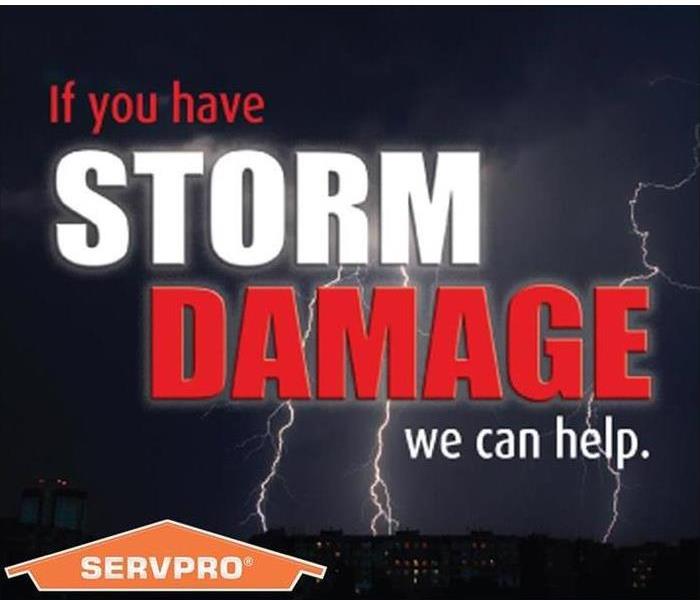 An all volunteer group from Louisiana known as "The Cajun Navy" gathered by the hundreds during the aftermath of Hurricane Harvey aid rescue efforts.
An all volunteer group from Louisiana known as "The Cajun Navy" gathered by the hundreds during the aftermath of Hurricane Harvey aid rescue efforts.
After the onset of Hurricane Harvey, many homes both in flood zones and out were trapped underneath the gulf waters. Those in Dickinson who believed to be safe soon found themselves in danger. So what should you do if you get put into that situation?
I Am Trapped By Water! What Now?
Don'ts:
- Do Not Panic. This is the most common bit of advice. Keeping a cool head will allow you to develop the best plan of action.
- Do Not try to drive through the water. Trust us on this one, even if you have a heavy duty truck it only takes two feet of water to wash it away.
- Do Not call 911 if your life is NOT in immediate danger. But DO advise a family member of your current situation.
Do's:
- Be prepared to get on the roof or up high. If there is no opening, make one. Only do this if the water is just beginning to come into your home.
- Unplug all electronics and put them up high. If you end up having to swim through the water you will avoid a 'shocking' situation.
- Move your furniture to someplace higher, if you can. If the water is only coming in a little put blocks underneath the feet of the furniture to give it a little lift.
- Write all information you need to remember on your arm in case the power goes out or you lose the documents. Ex: Emergency numbers and Social Security (if you don't know it).
- Be patient. The flood waters will go down, there is not much else you can do until it does.
To monitor the flood gauges near you, we recommend looking at this map.
For advice on your chances of flooding, see here.
 Always remember if you ever find yourself with a failed roof causing water damage to your home and in need of repairs after call SERVPRO.
Always remember if you ever find yourself with a failed roof causing water damage to your home and in need of repairs after call SERVPRO.





 24/7 Emergency Service
24/7 Emergency Service





























